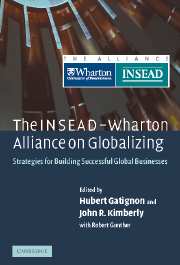Book contents
- Frontmatter
- Contents
- List of figures
- List of tables
- Notes on contributors
- Foreword
- Acknowledgments
- 1 Globalization and its challenges
- Part I Leading the global organization
- Part II Global market participation
- 6 Globalization through acquisitions and alliances: an evolutionary perspective
- 7 Developing new products and services for the global market
- 8 Managing brands in global markets
- 9 Global marketing of new products
- 10 Global equity capital markets for emerging growth firms: patterns, drivers, and implications for the globalizing entrepreneur
- Part III Managing risk and uncertainty
- Part IV Implications and conclusions
- Author index
- Subject index
6 - Globalization through acquisitions and alliances: an evolutionary perspective
from Part II - Global market participation
Published online by Cambridge University Press: 14 January 2010
- Frontmatter
- Contents
- List of figures
- List of tables
- Notes on contributors
- Foreword
- Acknowledgments
- 1 Globalization and its challenges
- Part I Leading the global organization
- Part II Global market participation
- 6 Globalization through acquisitions and alliances: an evolutionary perspective
- 7 Developing new products and services for the global market
- 8 Managing brands in global markets
- 9 Global marketing of new products
- 10 Global equity capital markets for emerging growth firms: patterns, drivers, and implications for the globalizing entrepreneur
- Part III Managing risk and uncertainty
- Part IV Implications and conclusions
- Author index
- Subject index
Summary
Although acquisitions and alliances are used increasingly to drive the growth in multinational activities, the success rates of both acquisitions and alliances continue to be considered low, both at home and abroad. How do companies make the choice between acquisitions and alliances as a mode of entry? How do they then approach the post-entry managerial challenges? And, most important, how do companies effectively learn to tackle these problems in a systematic way? The authors examine a variety of factors that might influence the entry choice, including feasibility, flexibility, information asymmetry, digestibility, time horizon, focus on core vs. periphery, and post-agreement hazards. They also explore distinctive post-entry competencies that affect the success of both alliances and acquisitions: an integration capability for the former dimension and relational capability for the latter. The authors stress the strategic value of deliberate investments in assessing and improving one's own capability levels in the management of these entry tools. For example, spending time on understanding one's own organization's less tangible qualities, such as its cognitive and cultural traits, needs to become part of the standard due diligence process. To achieve positive outcomes, the authors say, managers should invest in knowledge management mechanisms that can first identify, and then articulate and codify the processes idiosyncratic to their firms that produce positive results. These processes, along with skilled managers, constitute the competencies needed to achieve success more consistently in these external modes of globalization.
- Type
- Chapter
- Information
- The INSEAD-Wharton Alliance on GlobalizingStrategies for Building Successful Global Businesses, pp. 129 - 158Publisher: Cambridge University PressPrint publication year: 2004
- 3
- Cited by



